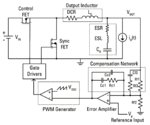kah89
Junior Member level 2
Hi,
I have a question about the stability analysis of the Buck converter
the circuit of buck is a combination between analog and digital how to model the digital circuits to make the stability and loop analysis
Thanks in advance
I have a question about the stability analysis of the Buck converter
the circuit of buck is a combination between analog and digital how to model the digital circuits to make the stability and loop analysis
Thanks in advance
